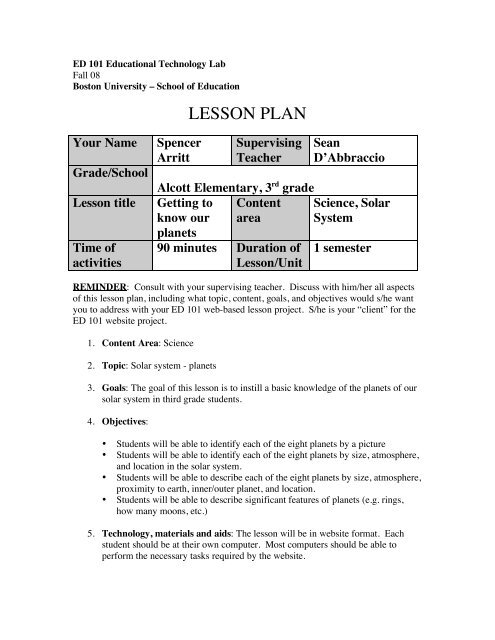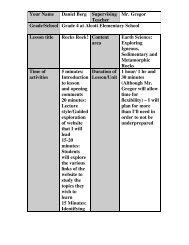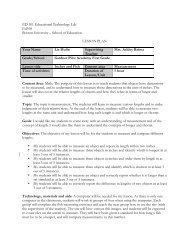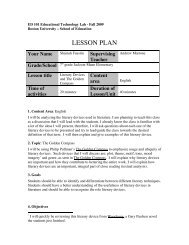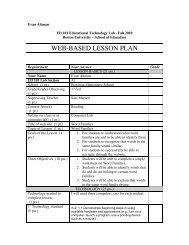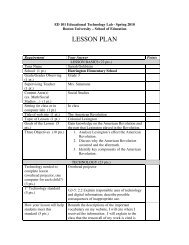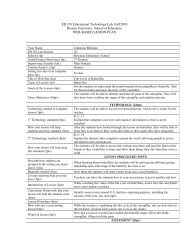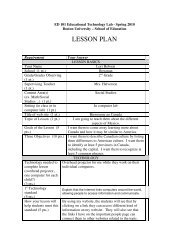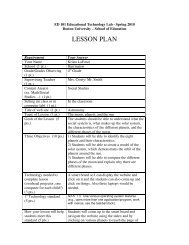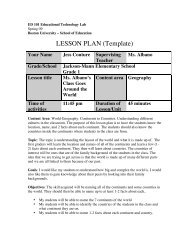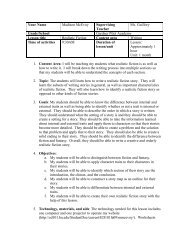LESSON PLAN - ED101 - Boston University
LESSON PLAN - ED101 - Boston University
LESSON PLAN - ED101 - Boston University
Create successful ePaper yourself
Turn your PDF publications into a flip-book with our unique Google optimized e-Paper software.
ED 101 Educational Technology LabFall 08<strong>Boston</strong> <strong>University</strong> – School of Education<strong>LESSON</strong> <strong>PLAN</strong>Your NameGrade/SchoolLesson titleTime ofactivitiesSpencerArrittSupervisingTeacherAlcott Elementary, 3 rd gradeGetting to Contentknow our areaplanets90 minutes Duration ofLesson/UnitSeanD’AbbraccioScience, SolarSystem1 semesterREMINDER: Consult with your supervising teacher. Discuss with him/her all aspectsof this lesson plan, including what topic, content, goals, and objectives would s/he wantyou to address with your ED 101 web-based lesson project. S/he is your “client” for theED 101 website project.1. Content Area: Science2. Topic: Solar system - planets3. Goals: The goal of this lesson is to instill a basic knowledge of the planets of oursolar system in third grade students.4. Objectives:• Students will be able to identify each of the eight planets by a picture• Students will be able to identify each of the eight planets by size, atmosphere,and location in the solar system.• Students will be able to describe each of the eight planets by size, atmosphere,proximity to earth, inner/outer planet, and location.• Students will be able to describe significant features of planets (e.g. rings,how many moons, etc.)5. Technology, materials and aids: The lesson will be in website format. Eachstudent should be at their own computer. Most computers should be able toperform the necessary tasks required by the website.
6. Procedures/methods:a. Overview: Students will make their way through the website individually,after a brief introduction from the instructor.b. Introduction: In the classroom, the instructor will introduce the lesson byexplaining what the website is about. The students should be told thatthey will be going to the computer lab to learn about/review informationabout the planets of the solar system on a website, which will be explainedupon their arrival in the computer lab.c. Activities:I. Introductiona. Explain to the students that they will be using the computer lab today tolearn about the planetsb. Walk the students to the computer labc. Demonstrate the websitei. Instruct the students to open a web browserii. Direct the students to the websiteiii. On the overhead, briefly show how the website works1. Show different pages of the site2. Explain the menu function3. Show the students where the assessment for the end of theactivity is locatedII. Main sectiona. Allow the students to explore the website, supervise as necessaryb. After about 45 minutes, instruct the students to go to the assessmentsection of the websitec. Give the students 20 minutes to complete the assessmentIII. Reviewa. Return to the classroomb. As a large group, ask the students what they learned from the websitec. Ask the students’ opinions on the website activityd. Follow-up: This lesson is part of the solar system science unit. Thestudents will use the information gained in the lesson on the post-test forthe unit.Technology Frameworks:G3-5: 1.17 Identify and use terms related to the Internet (e.g., Web browser, URL, keyword, World Wide Web,search engine, links).G3-5: 1.4 Demonstrate intermediate4 keyboarding skills and proper5 keyboarding techniques.
G3-5: 1.1 Demonstrate basic steps in using available hardware and applications (e.g., log into a computer,connect/disconnect peripherals, upload files from peripherals).Assessment: The assessment will focus primarily on knowledge level questions. Thislesson is meant primarily as a review tool, as the students have been learning about thesolar system all semester. The assessment will check on the students’ ability to findinformation on the website, as well as basic knowledge about the solar system.The assessment will consist of a review with five instant-feedback multiple choicequestions, followed by a graded assessment on Surveymonkey.com.Multiple Choice Review:1. About how much farther from the sun is Uranus than Saturn?a. Four times as farb. Half as farc. Twice as fard. Uranus and Saturn are about the same distance from the sun2. Which set of three planets have about the same gravity?a. Earth, Neptune, Uranusb. Mercury, Jupiter, Venusc. Mars, Mercury, Saturnd. Jupiter, Saturn, Neptune3. If Jupiter was 80 times larger, what would it be?a. One really big planet!b. A starc. A galaxyd. A moon4. Mercury’s surface is similar to that of _______.a. Earthb. Saturnc. The sund. Earth’s moon5. What is one way Uranus is different from every other planet?a. It is a gas giantb. It has multiple moonsc. Its south pole points toward the sun, instead of “down”d. It is named after an ancient godSurveymonkey test:
1. Put the planets of the solar system in order, from the closet to the sun (1) to the farthestfrom the sun (8).MercuryVenusEarthMarsJupiterSaturnUranusNeptune2. True or False: Earth is the only planet that can support life.True3. Which of these planets are gas giants (Hint: Think outer planets)?JupiterSaturnUranusNeptune4. Which planets are larger, the inner planets or the outer planets?Outer planets5. Your friend is thinking of moving to Venus, because he heard it is called "Earth'sTwin." You know this is a bad idea. Write a sentence giving a reason your friend shouldNOT move to Venus.Possible answers: No oxygen, no water, too hot, can’t support lifehttp://www.surveymonkey.com/s.aspx?sm=6lGWKAkrIy4FTGAW0xxXqQ_3d_3d


